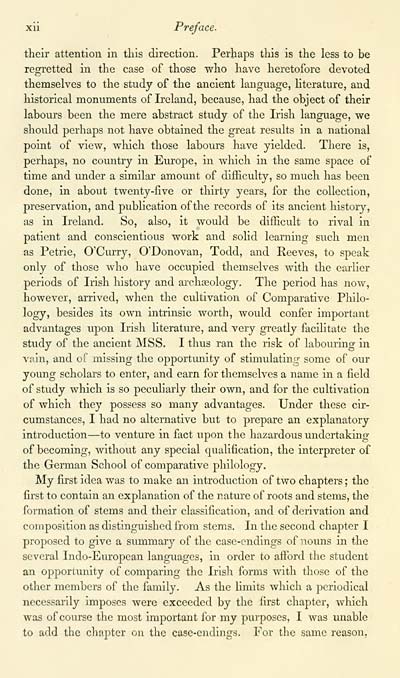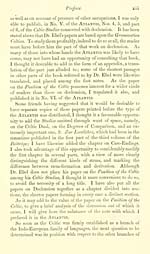Blair Collection > Celtic studies
(16)
Download files
Complete book:
Individual page:
Thumbnail gallery: Grid view | List view

xii Preface.
their attention in this direction. Perhaps tliis is the less to be
regretted in the case of those who have heretofore devoted
themselves to the study of the ancient language, literature, and
historical monuments of Ireland, because, had the object of their
labours been the mere abstract study of the Irish language, we
should perhaps not have obtained the great results in a national
point of view, wliich those labours have yielded. There is,
perhaps, no country in Europe, in which in the same space of
time and imder a similar amount of difficulty, so much has been
done, in about twenty-five or thirty years, for the collection,
preservation, and publication of the records of its ancient history,
as in Ireland. So, also, it would be difficult to rival in
patient and conscientious work and solid learning such men
as Petrie, O'Curry, O'Donovan, Todd, and Peeves, to speak
only of those who have occupied themselves with the earlier
periods of Irish history and arohaiology. The period has now,
however, arrived, when the cultivation of Comparative Philo-
logy, besides its own intrinsic worth, would confer important
advantages upon Irish Hterature, and very greatly facilitate the
study of the ancient MSS. I thus ran the risk of labouring in
voin, and of missing the opportimity of stimulating some of our
young scholars to enter, and earn for themselves a name in a field
of study which is so peculiarly their own, and for the cultivation
of which they possess so many advantages. Under these cir-
cumstances, I had no alternative but to prepare an explanatory
introduction — to venture in fact upon the hazardous undertaking
of becoming, without any special qualification, the interpreter of
the German School of comparative philology.
My first idea was to make an introduction of two chapters; the
first to contain an explanation of the nature of roots and stems, the
formation of stems and their classification, and of derivation and
composition as distinguished from stems. In the second chapter I
proposed to give a smnmary of the case-endings of nouns in the
several Indo-European languages, in order to afford tire student
an opportunity of comparing the Irish forms with those of the
other members of the family. As the limits which a periodical
necessarily imposes were exceeded by the first chapter, which
was of course the most important for my purposes, I was unable
to add the chapter on the case-endings. For the same reason,
their attention in this direction. Perhaps tliis is the less to be
regretted in the case of those who have heretofore devoted
themselves to the study of the ancient language, literature, and
historical monuments of Ireland, because, had the object of their
labours been the mere abstract study of the Irish language, we
should perhaps not have obtained the great results in a national
point of view, wliich those labours have yielded. There is,
perhaps, no country in Europe, in which in the same space of
time and imder a similar amount of difficulty, so much has been
done, in about twenty-five or thirty years, for the collection,
preservation, and publication of the records of its ancient history,
as in Ireland. So, also, it would be difficult to rival in
patient and conscientious work and solid learning such men
as Petrie, O'Curry, O'Donovan, Todd, and Peeves, to speak
only of those who have occupied themselves with the earlier
periods of Irish history and arohaiology. The period has now,
however, arrived, when the cultivation of Comparative Philo-
logy, besides its own intrinsic worth, would confer important
advantages upon Irish Hterature, and very greatly facilitate the
study of the ancient MSS. I thus ran the risk of labouring in
voin, and of missing the opportimity of stimulating some of our
young scholars to enter, and earn for themselves a name in a field
of study which is so peculiarly their own, and for the cultivation
of which they possess so many advantages. Under these cir-
cumstances, I had no alternative but to prepare an explanatory
introduction — to venture in fact upon the hazardous undertaking
of becoming, without any special qualification, the interpreter of
the German School of comparative philology.
My first idea was to make an introduction of two chapters; the
first to contain an explanation of the nature of roots and stems, the
formation of stems and their classification, and of derivation and
composition as distinguished from stems. In the second chapter I
proposed to give a smnmary of the case-endings of nouns in the
several Indo-European languages, in order to afford tire student
an opportunity of comparing the Irish forms with those of the
other members of the family. As the limits which a periodical
necessarily imposes were exceeded by the first chapter, which
was of course the most important for my purposes, I was unable
to add the chapter on the case-endings. For the same reason,
Set display mode to: Large image | Transcription
Images and transcriptions on this page, including medium image downloads, may be used under the Creative Commons Attribution 4.0 International Licence unless otherwise stated. ![]()
| Early Gaelic Book Collections > Blair Collection > Celtic studies > (16) |
|---|
| Permanent URL | https://digital.nls.uk/75771358 |
|---|
| Description | A selection of books from a collection of more than 500 titles, mostly on religious and literary topics. Also includes some material dealing with other Celtic languages and societies. Collection created towards the end of the 19th century by Lady Evelyn Stewart Murray. |
|---|
| Description | Selected items from five 'Special and Named Printed Collections'. Includes books in Gaelic and other Celtic languages, works about the Gaels, their languages, literature, culture and history. |
|---|

